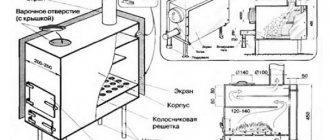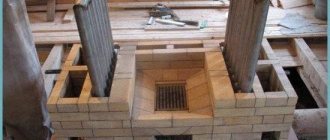- At the location of the water tank
- Sauna stove with boiler
- What you need to know about operation
- Coil for furnaces
Having made the right choice of heating equipment, you can steam and wash without purchasing and installing a boiler. A reliable, modern, spacious heat exchanger for a bath will perfectly cope with the role of a heater: it will be able to supply the required volume of hot water to the storage tank. In this article you will learn about the options and operating features of the technical tool that exist today, practical advantages and the most popular models.
What it is
The device is used to heat water in the bath. Its operating principle is based on the physical properties of hot water, expanding and rising upward, while cold water remains below.
Typically the heat exchanger is small in size, so the liquid in it heats up quickly. Two pipes are connected to it - below and above. Thus, hot water through the upper pipe, replaced by cold water from below, rises into the tank, which can be located either in the steam room or in an adjacent room, usually in the sink. In this case, low-temperature water is constantly added to the heating device through the lower pipe without forced supply.
Options for heating water in a bath from a stove
The following models are distinguished:
1. Samovar-type container - installed on the outlet pipe of the chimney. Heating occurs due to the heat of the flue gases escaping into the chimney. A tap for dispensing hot water is connected to the fitting at the bottom of the tank. If you don’t have a washing machine, then this option will be an excellent solution for heating. We recommend paying attention to the following operating conditions:
- the use of a samovar-type tank is allowed only with bathhouse stoves;
- It is prohibited to operate an empty tank while the stove is operating;
- If you want to get a “Finnish sauna”, this option for heating water will not suit you, since if the steam room is heated for a long time, the liquid will begin to boil, which is why heavy steam is formed.
2. A samovar-type heat exchanger (small in size with the ability to connect to a tank), which can be located anywhere. It is convenient because, if available, the tank can be placed in the washing room. One of the obvious advantages over other options is that it quickly heats the water.
3. Heat exchanger, which is installed on the starting chimney.
4. Starting chimney + tank-backpack - an option with being in a steam room and the absence of controlled convection to warm up the room. The container comes into contact with the wall of the chimney pipe, due to which the liquid is heated. Among the disadvantages, it can also be noted that this model does not have protection from hard infrared radiation, and in case of strong heating, the water begins to boil.
5. Convector chimney with a heater built into it.
Features: the register is located inside a pipe from which 2 identical ¾-inch fittings with internal thread come out. Using pipes, the device is connected to a tank hanging in a convenient place.
May be:
- Built into the oven - when scale appears, it loses efficiency.
- Located near the chimney (on it) - it provides heating to the required temperature more slowly, but nothing settles on its inner surface, it is easy to access, and its repair is not difficult.
The choice depends on the user: what to give preference to, performance or ease of maintenance, saving usable space or fuel.
Purpose and principle of operation
The operating principle of different types of heat exchangers is the same: water is heated by the heat from the burned fuel in the stove and is then used for washing or heating. In this case, there is no need to install a separate boiler in the bathhouse.
Depending on the location, the heat exchanger can be:
- built-in (internal, integrated, as they also say);
- external (to the chimney).
It is made in the form of a coil or container, which is heated by heat from the firebox or chimney pipe. The samovar heat exchanger is external and works like a samovar, heating up due to hot gases from the burned fuel.
Tubes are welded into the heat exchanger through which water flows in and out. Hot water enters a tank, which is placed either next to the heat exchanger or taken to another room. The pipes can be positioned so that the water constantly circulates while heating in the sauna stove.
Difference by type
The simplest designs of heat exchangers are coils with ends removed from the tank: one takes in liquid at room temperature, the other releases hot liquid.
More complex ones are a system consisting of two metal tanks with anti-corrosion properties - cylindrical and rectangular in shape with connecting pipes.
At the location of the water tank
There are two ways:
- This photo shows an option for installing a heat exchanger in a steam room and a tank in a wash room.
- The second option is to install a heat exchanger with a tank inside the steam room.
Advantages of installing a heat exchanger in a steam room
- high water heating speed;
- saving free space in the steam room;
- Wide range of options for installing the tank - in a steam room or in a shower room.
At the location of the warm water tank
Depending on where the container with water is located, the following types of heaters are distinguished:
- The container directly in the steam room allows the water to heat up faster, since there is no or very short water supply. Heat loss is also reduced. The disadvantage is quite obvious: the usable area of the steam room is reduced.
- The container is located in the adjacent room where the shower is equipped. This option is often recommended. It is more convenient to wash in a separate shower and there is more space in the steam room. But the length of the water pipeline is increasing.
- The problem of low pressure can be solved by installing a coolant tank in the attic. This method is also not without its drawbacks. It is necessary to bring cold water upstairs, and the length of the hot water supply is longer. The container must be carefully insulated to minimize heat loss.
Features of installation and operation of the heat exchanger
Installed between the firebox and convector:
- built into the oven;
- attached to the chimney;
- or built into it.
The productivity of the device with a capacity of 5 liters is enough to quickly fill a 120-liter tank with hot water. It’s easy to use – just organize a timely supply of liquid (uninterrupted operation can be ensured by using a circulation pump) and “feed” the firebox with firewood.
When installing a heat exchanger (recuperator) for a bath, the following points must be taken into account:
- the total length of pipes for water supply should be laid at 3 m, which minimizes heat loss;
- with a connecting pipe diameter of 1 inch, it is permissible not to use a circulation pump.
The longer the heat exchanger is in use, the more justified the installation is from an economic point of view.
System installation methods
Correct placement of all system components allows for its ideal functioning . To achieve this result, the tank is placed on the wall above the level of the heat exchanger. The larger and smaller containers are connected by two pipes. Installation is carried out according to certain rules :
- the hot water supply pipe to the large tank has an inclination to the horizon of up to 30 °;
- another pipe passes below, cold water flows through it for heating towards the stove, its angle of inclination is approximately 1 - 2 °. A water drain tap is located on the lower pipe, and the water tank is equipped with a tap for disassembly.
An important condition for the reliable operation of the system is the mandatory filling of it with water before starting the fire, otherwise depressurization of welds or connecting areas may occur.
Filling a hot tank with cold water can lead to a breakdown of the entire system. Experienced craftsmen advise installing the tank so that the distance from the firebox to it is no more than 3 meters , and the connecting pipes should correspond in diameter to the selected type of equipment. It is generally accepted that it is acceptable to use pipes with a minimum cross-section of 1 inch . Otherwise, the process of convection exchange between hot and cold liquid will be hampered, and the liquid will not be able to move efficiently through the pipes. If such a problem bothers you, then the use of electric pumps is recommended; they pump water through the system, improving its circulation.
Rules for installing a heat exchanger on a sauna stove
The following rules must be followed:
- The heat exchanger must consume no more than 10% of the total energy produced by the furnace, then the latter will operate with good efficiency.
- The pipes must be laid so that the water flows by gravity, that is, at a 250-degree slope on the direct supply and 30-degree on the return one.
- It is important to reserve power for cooling after fuel burns.
- It is necessary to provide a sufficient volume of water for each individual model, because if there is too little of it, it will boil quickly, which can lead to the formation of deposits on the walls and a fire hazard, and if there is too much, you will have to wait a long time before taking a shower.
How to connect a heat exchanger if the tank is in a steam room:
- The entrance to the hot water tank should be at least 5 cm higher than the upper register fitting. This is necessary for better circulation.
- The upper register is from 1.4-1.5 m from the floor, despite the fact that the podium under the stove is 15 cm. The bottom of the tank in the steam room should be at least 1.5 m, and preferably higher.
- If the tank is 0.5 m high, then we have a total installation of 2.0 m. That means there is still half a meter to the ceiling. And here the question arises: how to fill the liquid. If there is a running water supply, then water will flow without problems.
Second connection option: we place the tank lower, and place the fitting for the supply circuit on the side. But there is a nuance: if the water level is below the upper fitting, there will be no circulation. It will stand in the heat exchanger and periodically reach a boil, but in the tank it will remain cool.
If you need to place the tank in the wash room, you should follow the same principles as when placing it in the steam room.
How to make your own heat exchanger
In order to make this element with your own hands, you will need metal plates 2.5-3 mm thick, a welding machine and the ability to use it. Two containers are connected - the lower and upper ones by pipes.
Make sure all seams are sealed. If a sauna stove with a heat exchanger will be used in the form of a boiler, and heat will be distributed from it to the radiators, calculate its size and the diameter of the pipes based on the size of the sauna premises.
Tip: check the presence of water in the tank before you start heating the stove.
Area calculation
When making calculations, you should know that 1 m2 of heat exchanger can produce up to 9 kW of power with a normal firebox. If we take into account that for a bathhouse 5 m by 5 m approximately 5 kW is required, we can determine the approximate size of the future device.
Do not forget that a lot depends on where the sauna stove with heat exchanger is located and on the intensity of fuel combustion. Therefore, it is necessary to immediately take a multiple reserve when calculating.
Placing the stove and removing the heating tank with water
Examination
Prepare parts cut from a metal sheet, tack them by welding, check the calculations and finally secure them together.
After that, check the system like this:
- Weld the down pipe.
- Fill the system with liquid to the very top.
- Connect the outlet to the container.
- Begin filling the system with compressed air, observing the pressure on the pressure gauge.
- Re-brew possible leaks by draining the liquid first.
Tip: make sure that the total number of pipes and joints is minimal.
Advantages
Although the cost of upgrading conventional stoves or creating custom units will be higher than conventional sauna units, it is worth it.
Let's understand what advantages sauna stoves with a heat exchanger provide:
- You get 3 in 1: creating steam, heating rooms and getting hot water.
- The heat exchanger allows you to move the hot water tank to the place you need.
- Modern materials contribute to the long service life of such products.
- Often these stoves have a firebox with heat-resistant glass, which makes it easier to control combustion and allow you to enjoy the flame.
- The device is especially in demand in baths, where the steam room and washing room are located in different rooms.
- The appearance of a stove with a heat exchanger is quite attractive, and their operation does not cause any hassle.
- The devices are compact, which saves space.
- The ovens are suitable for both wet and dry steam.
- The rigidity of the structure allows the devices not to deform when heated.
Removing the firebox with heat-resistant glass to the rest room
Safety regulations
- It is prohibited to attach pipes from the heat exchanger to the wall with fixed connections. When heated, they can change their size and damage them.
- The heat exchanger power should be no more than 10% of the furnace power.
- The volume of the remote water tank should be warmed up no earlier than two hours after the start of the fire.
- Do not pour water into an oven that is heated to a high temperature.
How and how to connect the external tank to the heat exchanger
Remember that the elements in contact with the stove become hot, their surface temperature exceeds 100 0C. Therefore, the pipes must be made of stainless steel (cast iron will not work, as it is susceptible to corrosion). But ordinary pipes are allowed to be made of metal-plastic; they can even be replaced with flexible hoses. The main thing is that the diameter is 1 inch or 3/4, otherwise the circulation will be poor.
Use tangit for seals, and paronite for fittings. Feel free to replace factory elements with non-standard ones, but made of heat-resistant material. Don't forget about the drain valve - it is simply necessary to preserve the system for the cold season or to quickly remove stagnant liquid. Otherwise, during frosts, the remaining water will freeze and burst the pipes.
Calculation of heat exchanger area
A stove for a bath with a heat exchanger for heating should produce 5 kW of heat with a standard area for an ordinary family. When independently calculating the dimensions of the system elements, we proceed from the fact that 1 m2 of heat exchanger area gives about 9 kW.
It is recommended to make dimensions with a large margin, since the efficiency of the system is affected by the location and shape of the boiler, and the quality of the fuel.
When designing a system for obtaining hot water (with a remote tank), it should be taken into account that the tank itself will additionally heat the room.
The connection diagram for the heat exchanger in the bath is simple for factory-made stoves in the corresponding models. However, for people with welding skills, it is quite possible to assemble the system on their own for a brick oven. For a system with natural circulation, you will need pipes, fittings, fittings (2 taps), and a water tank.
Metal sheets are needed if the water tank or heat exchanger is to be welded independently (in the shape of a cube or parallelepiped).
Review of furnaces with heat exchanger
There are built-in models of heat exchangers. Below we will look at the popular ones.
Sauna stove with boiler
Let's start with how justified such a decision is from an economic point of view. Installation of this device increases the efficiency of the equipment used. With it, exhaust gases not only fly away uselessly into the atmosphere, but also simultaneously heats water, which can then be used for bathing or other household needs. Therefore, it repeatedly justifies the fact of its installation in the long term.
Vesuvius Skif 16 VChT
Powerful and fast, with a right- or left-side location of the water heater, equipped with a mesh. It boasts a steel firebox with thick walls (8 mm), thanks to which it is not afraid of even constant exposure to high temperatures.
Tornado 20M2
Productive, heavy (125 kg). Equipped with a cast iron door, built-in heat exchanger and a spacious side casing designed for 240 kg of stones. Must be installed on a reinforced foundation. But the efficiency is impressive.
Harvia 20SL Boiler
A heater from a Finnish manufacturer, weighing 75 kg, with 40 kg of stones. Modern, with a recuperator in the form of a tank, with a remote structure and a built-in condenser, designed for a steam room with an area of up to 20 m3. It has stable legs and a stainless frame, has smooth shapes and an attractive design.
Types of fuel for furnaces with a water circuit
The entire range of combustion furnaces can be divided into three large groups: solid fuel, liquid and gaseous.
Solid fuel stoves
Wood-burning stoves with a water circuit continue to remain a true and timeless classic. The design, classic for a traditional bath, is complemented by a heat exchanger, mains and heating radiators. However, fuel efficiency sometimes makes one look for more innovative and technologically advanced options. These include products such as a pellet stove with a water circuit. This design is justified in places where there is no mass logging, but wood processing is sufficiently developed.
Wood processing waste is the main raw material for the production of pellets. Agriculture is also an important supplier of raw materials. Straw, corn and sunflower stalks, buckwheat husks and seeds are successfully used in the production of fuel pellets. An important advantage of this design, compared to a conventional wood-burning one, is the possibility of partial automation of the processes of storage, loading of fuel and its combustion.
If you have at your disposal a large amount of wood waste, or even just outright plant debris, then you should pay attention to long-burning stoves with a water circuit. Their operation is associated with the combustion process with a small amount of oxygen and is more reminiscent of smoldering than full combustion.
Especially from the cohort of solid fuels, it is worth mentioning coal sauna stoves, to which we have already devoted separate material.
Liquid fuel stoves
Fuel oil, boiler and heating oil are used quite rarely in the bathing industry. Basically, liquid fuel is the lot of outdated large public baths and more modern mobile bath complexes.
In private bathhouses, designs such as waste oil stoves have found particular application. Users of such units are primarily attracted by the low, and sometimes even free, cost of fuel.
Attention! In our materials, we never tire of saying that the bathhouse is a stronghold of environmental friendliness and the kingdom of natural materials. An exhaust furnace with a water circuit is very weakly associated with this. Therefore, if you are attracted by cheapness, then do not be lazy to arrange a separate room for the boiler room, and you should completely forget about such a concept as a flow-through heater.
Gas-fueled stoves
They are a good alternative to traditional wood stoves. Significant restrictions on their use are imposed by the fact of weak gasification of the domestic periphery and increased requirements for the culture of their operation, due to the high explosion hazard of gas fuel.
We deliberately did not mention one more type of stove. Based on electrical heating. But since furnaces of this type are a very broad area, it would be better to separate the story about them into a separate topic.
Separately, it is worth mentioning the independent production of such a stove. Since, after all, seeing once is better than reading twice, we cover this topic in video format, where everything is clear, understandable, and visual.
Installation and connection of the heat exchanger and tank in the bath
- Find a suitable location to mount the remote tank. If all the structural parts are located in one room, it is most often hung on the wall closest to the heating unit, 200-300 mm above the recuperator.
- Secure the wooden dies with dowels - these are the guides on which you will hang the tank. This is necessary so that the container does not touch the interior elements with its hot surface.
- Strengthen the assembly with brackets for greater reliability.
- Equip the remote tank with 4 pipes, then, using fittings, connect the first two with the corresponding ones at the tank (for direct and reverse water supply), close the third with a valve, and connect the shower (faucet) to the fourth.
- Install (at the lowest point) a valve on the reverse line to drain the water.
- Connect all elements and check the system for leaks.
What you need to know about operation
If you have read the instructions and purchased a heat exchanger for your bath, make sure that the following conditions are met:
- Fastening connections must be movable - this will help minimize deformation of the recuperator components under the influence of high temperatures.
- Seals must be made of heat-resistant materials.
- The capacity of the remote tank is selected so that it can accommodate the volume of water heated in 2 hours.
- It is important that full compatibility with the heating unit is maintained.
- The device should consume no more than 10% of the energy generated by the oven.
Operational safety
To prevent emergency situations, observe the following precautions:
- do not attach pipes directly to walls;
- Make sure that there is always enough water in the tank, otherwise you will quickly encounter a scale problem or even a fire hazard;
- constantly check the operation of the device and sound the alarm if it suddenly breaks down;
- Use only heat-resistant gaskets and regularly pay attention to their condition.
Conclusion
Installing a heat exchanger on a sauna stove does not require much work. To do this, just follow the instructions above. The main principle is compliance with slopes. Photo No. 1 shows one of the heat exchanger options for a bath and its installation. Otherwise, problems will arise with the pressure. When organizing water heating, you should adhere to the following rules:
- The length of the forward and return pipes should not exceed three meters.
- The remote tank is placed at such a height that the slopes are maintained. The excess must be at least 100 mm.
- Pipes for the heat exchanger of a sauna stove for heating water must be made of stainless steel or copper.
- The water in the system must not be allowed to freeze; it must be drained after each use of the steam room. A special valve is provided for this. It also serves as an emergency drain if an accident occurs.
- The power should be selected so that the device heats the required amount of water to +700C in 2 hours. The liquid in the system should not boil. Scale quickly damages the device.
- The diameter of the pipelines should not be less than 24 mm.
By following these simple rules, you will always have hot water and save money on installing an electric boiler.
The simplest heat exchangers
To make choosing a unit easier, we suggest you familiarize yourself with the following options.
Coil for furnaces
The simplest version of a heat exchanger is a pipe (made of aluminum, copper or other ductile and anti-corrosion metal), bent into a spiral or, less commonly, of a different shape. The carrier effectively moves along it by gravity if its total length is less than 3 m. It is heated by hot air, and not by contact with fire. At the ends of this design, threads are made (external) for a fitting connection with the tank.
The coil can be placed directly in the firebox, inside or outside it. Its shape can be very different, starting from the simplest U-shaped horseshoes, continuing with the already mentioned spirals with different numbers of turns, and ending with complex welded registers. The latter are done to increase reliability and reduce energy losses, but since they are large in size, they are usually placed in spacious heaters.
Rectangular tank on a pipe
This is another type - no longer an internal cylindrical container, but a structure consisting of an airtight body made of stainless steel.
The principle of operation remains the same - the heated liquid rises into the reservoir, the cooled liquid goes back. In implementation, a chimney with a diameter of Ф115mm (without the use of an adapter) or 110mm (with use) is suitable for it, and exhaust steam entering the room is almost excluded. True, the system must be sealed; it is important to replenish the structure with water in a timely manner.
Recommendations from experienced professionals
Here are some more tips on how to install a heat exchanger in a bathhouse as rationally as possible:
- If you do not plan to use a circulation pump, make the pipeline at a slope of 50 so that the liquid moves due to gravity.
- Do not take a tank that is too large and/or do not pour too much water into it, as it simply will not have time to reach a comfortable temperature in the time you need.
- Pay maximum attention to sealing - during assembly, do not hesitate to check the quality of each connection several times.
Choose durable materials and a suitable design, make the calculations correctly, and strictly follow the instructions and recommendations. A competent master knows how to make and connect a heat exchanger in a bathhouse, because correct installation will be the key to safe operation of the equipment, and therefore a comfortable bathing after the steam room.
Finally, a video about how the universal heat exchanger model works:
Principles of installation, connection and safe operation
- Installation options depend only on the choice of location of the exchanger. The most difficult thing will happen if you decide to place it inside a finished oven , where it was not originally planned. For this you will have to disassemble the case and make holes. It is much easier to use a hanging structure or put a coil or a “samovar” on the chimney pipe.
- As for the pipes that connect the heat exchanger to the tank, for a gravity-flow design it is important to observe slopes, and also remember that the fastening of the pipes should not be rigid - allow them to “walk” freely during thermal expansion.
- The material for pipes is best copper , and connections are brass . When purchasing seals, pay attention to their ability to withstand high temperatures.
Operating safety depends on your awareness. The main thing is not to forget about two things:
- when leaving the bathhouse, you need to drain all the water from the system;
- You should not start heating without making sure that the storage tank is full of water.
If a brick oven with an internal water circuit is flooded and you forgot to add water in time, it is better not to do this when the oven is heated.
It is also important to prevent the liquid from boiling in the system.










